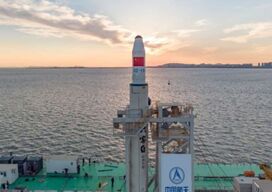"一箭九星"海上发射成功
Sea-based space launch
“一箭九星”海上发射成功
China launched a Long March 11 solid-propellant carrier rocket from a ship in the Yellow Sea on Tuesday morning, sending nine satellites into orbit in the nation's second sea-based launch mission.
9月15日上午,我国第二次海上航天发射任务在黄海海域执行,采用固体燃料作为推进剂的长征十一号运载火箭成功将9颗卫星送入预定轨道。
The Long March 11-HY2 blasted off at 9:22 am from the Debo 3, a self-propelled deck barge that was modified for the mission.
9时22分,长征十一号HY2运载火箭从经过改装的“德渤3号”动力驳船上腾空而起。

About 13 minutes later, after traveling 535 kilometers, it deployed nine Jilin 1 high-resolution Earth-observation satellites in sun-synchronous orbits.
大约13分钟后,成功将“吉林一号”高分03系列9颗地球观测卫星送入距离地面535公里的太阳同步轨道。
Each of the satellites, developed by Changguang Satellite Technology in Changchun, Jilin province, weighs about 42 kilograms. They will provide remote-sensing services to users in fields such as agriculture, forestry, land resources and environmental protection.
该型号卫星由吉林省长春市长光卫星技术有限公司研发,每颗重量约42公斤,将为林业、农业、国土资源、环境保护等行业用户提供遥感信息服务。
The mission helped to optimize seaborne launch procedures and improve the safety and reliability of such operations, laying a foundation for frequent sea-based launches in the future, said Jin Xin, the rocket's deputy project manager.
长十一火箭副总指挥金鑫说,此次发射任务进一步优化了海上发射技术流程,提升了海上发射技术的安全性和可靠性,为未来实现海上发射常态化、高频次奠定了基础。